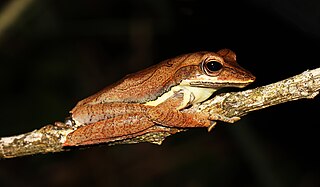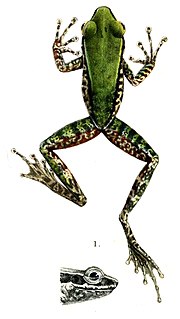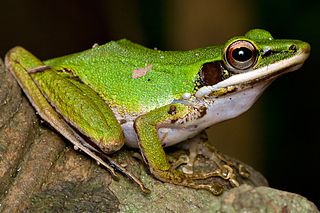
Amolops larutensis is a species of frog in the family Ranidae that is found in the Malay Peninsula from southernmost Thailand to Malaysia; records further north probably represent A. panhai.
Meristogenys amoropalamus is a species of frog in the family Ranidae. It is endemic to northern Borneo and occurs in northwestern Sabah and northeastern Sarawak (Malaysia) and in northeastern Kalimantan (Indonesia). Common names mountain Borneo frog and mountain torrent frog have been coined for it. Studies of its larvae revealed that the nominal species contained two cryptic forms, and in 2011, Shimada and colleagues described Meristogenys dyscritus as a separate species.
Meristogenys poecilus is a species of frog in the family Ranidae. It is endemic to Borneo and known from between central Sarawak (Malaysia) and central Kalimantan (Indonesia). The specific name poecilus is derived from the Greek poikolos, meaning "pied" or "blotched", in reference to diagnostic pattern on rear of the thigh. Common name Malaysian Borneo frog has been coined for this species.
Platymantis montanus is a species of frog in the family Ceratobatrachidae. It is endemic to southwestern Luzon, the Philippines, and is known from its type locality, Mount Banahaw, and from Mount Apoy.

Pseudophilautus viridis, or the dull-green shrub frog, is a species of frogs in the family Rhacophoridae. It is endemic to Sri Lanka and occurs in the central hills of south-central Sri Lanka.

Taruga fastigo is a species of frogs in the family Rhacophoridae. It is endemic to Sri Lanka and only known from its type locality, Morningside Estate near Rakwana. Prior to its description in 2001, it was confused with Polypedates eques.
Leptomantis rufipes is a species of frog in the family Rhacophoridae. It is endemic to Borneo and known from isolated locations in south-central Sarawak and eastern Sabah and central Kalimantan (Indonesia). Common names Malaysian flying frog and red-legged frog have been coined for this species. The specific name rufipes refers to the red webbing of this frog.
Papurana attigua is a species of frog in the family Ranidae, the "true frogs". It is found in central and south Vietnam, eastern Cambodia, and southern Laos. The specific name attigua is derived from Latin attiguus meaning "neighbor". It refers to the similarity of this species to Indosylvirana milleti. The common name similar frog has been coined for this species.
Pulchrana banjarana is a species of true frogs, family Ranidae. It is endemic to the Malay Peninsula, occurring from the extreme southern Thailand to Peninsular Malaysia; however, it might also occur in Sumatra (Indonesia). The specific name banjarana is derived from the Malay word for "mountain range", banjaran, and refers to the distribution of this species in the highlands of the Malay Peninsula.
Chalcorana chalconota is a species of "true frog", family Ranidae. It is endemic to Indonesia and occurs in southern Sumatra, Java, Bali, and a few smaller islands. Populations previously assigned to this species now belong to a number of other Chalcorana species, leading to the current delineation of Chalcorana chalconota with a much narrower range. This species is also known as the Schlegel's frog, brown stream frog, copper-cheeked frog, or, among with many other species, white-lipped frog.

Chalcorana macrops is a species of "true frog" in the family Ranidae. It is endemic to Sulawesi, Indonesia. Common name Masarang frog has been coined for it. The specific name macrops refers to the large eyes of this frog.

Chalcorana megalonesa is a species of true frog in the family Ranidae, the "true frogs". It is endemic to Borneo and is known from both Malaysia and Indonesia (Kalimantan). It was split off from Rana chalconota in 2009 by Robert Inger and colleagues, along with a number of other species. Common name large white-lipped frog has been coined for it.
Chalcorana parvaccola is a species of "true frog" in the family Ranidae. It is endemic to Sumatra, Indonesia. It was split off from Chalcorana chalconota by Robert Inger and colleagues in 2009, along with a number of other species. The specific name parvaccola is derived from Latin parvus meaning small and accola meaning neighbor, and refers to this species being smaller than its "neighbor", the related Sumatran species Chalcorana rufipes.

Chalcorana raniceps, also known as the copper-cheeked frog, white-lipped frog, or Peters' Malaysian frog, is a species of "true frog" in the family Ranidae. It is endemic to Borneo, including Brunei Darussalam, Kalimantan (Indonesia), and Sarawak (Malaysia), although it is likely to occur more widely. Previously mixed with Chalcorana chalconota and believed to have much wider distribution, its range was delimited to Borneo in the revision of "Rana chalconota" complex by Robert Inger and colleagues in 2009.
Chalcorana rufipes is a species of "true frog" in the family Ranidae. It is endemic to Sumatra, Indonesia. It was split off from Chalcorana chalconota by Robert Inger and colleagues in 2009, along with a number of other species. The specific name rufipes is derived from Latin rufus meaning reddish and pes meaning foot, in reference to the reddish tinge on the underside of the pedal webbing in life.
Chalcorana scutigera is a species of "true frog" in the family Ranidae. However, it is a poorly known species that might actually be synonymous with Polypedates leucomystax. It is endemic to Peninsular Thailand. Common names Haut Sanuk frog and yellow trea frog have been coined for it.
Papurana supragrisea is a species of true frog, family Ranidae. It is endemic to New Guinea, including some nearby islands. It is known with certainty only from southeastern New Guinea and from the D'Entrecasteaux Islands. However, this name has been used more broadly for a species complex that is widely distributed in the mountains of New Guinea. Common name Papua gray frog has been coined for it.

Indosylvirana indica, the Indian golden-backed frog, is a species of frog in the family Ranidae. It was formerly considered as conspecific with Indosylvirana temporalis but was found to be a distinct species in a 2014 study.
Meristogenys maryatiae, also known as Maryati's torrent frog, is a species of frog in the family Ranidae. It is endemic to the state of Sabah, in the Malaysian part of Borneo. The specific name honours Prof. Datin Mohamed Maryati, entomologist from the Universiti Malaysia Sabah, who helped the describers of this species during their herpetological surveys in Sabah.
Pulchrana centropeninsularis is a species of "true frog", family Ranidae. It is found in Peninsular Malaysia and Sumatra (Indonesia). The specific name centropeninsularis refers to the area of its original discovery, the state of Pahang in the central Peninsular Malaysia. Later on, it has also been recorded in the province of Jambi in east-central Sumatra. Pulchrana centropeninsularis is a rare species known from few individuals only. Prior to its description, Pulchrana centropeninsularis was confused with Pulchrana siberu, its closest relative.







